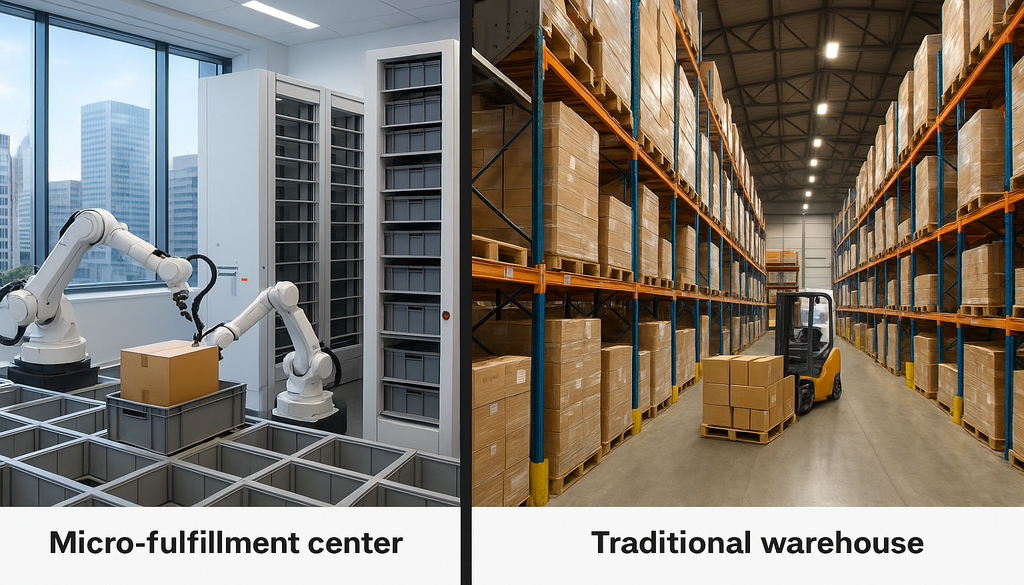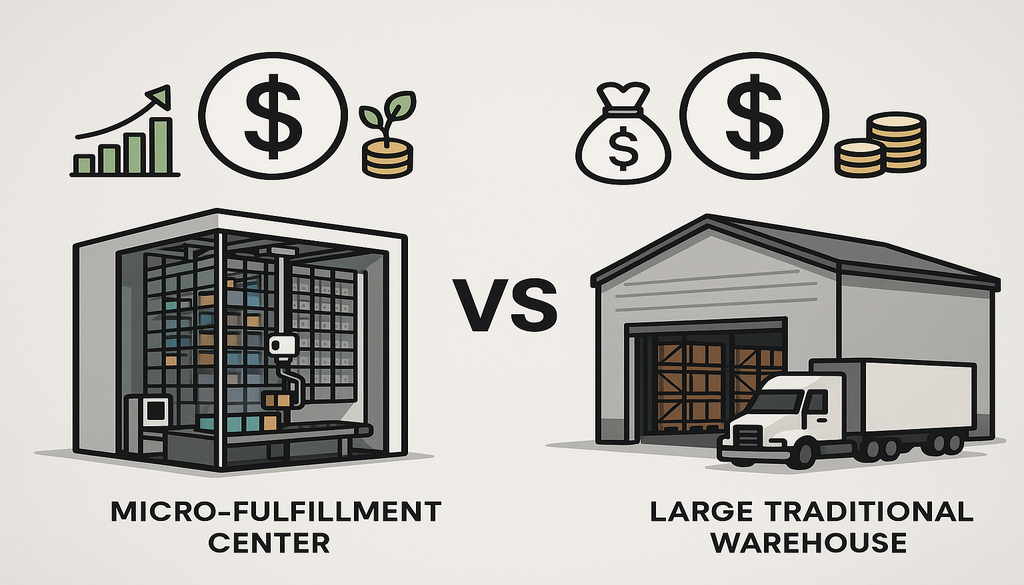In today’s rapidly evolving retail landscape, businesses face critical decisions about their fulfillment strategies. The choice between micro-fulfillment and traditional warehousing can significantly impact operational efficiency, customer satisfaction, and the bottom line. As e-commerce continues to grow and consumer expectations for faster delivery intensify, understanding the distinctions between these two models becomes essential for supply chain professionals. This comprehensive comparison explores how each approach addresses modern logistics challenges, helping you determine which strategy—or combination of strategies—best aligns with your business objectives and customer demands in the competitive retail fulfillment environment.
Defining Micro-Fulfillment and Traditional Warehousing
Micro-fulfillment centers (MFCs) represent a relatively new concept in the supply chain landscape, typically consisting of small-scale, highly automated facilities ranging from 3,000 to 10,000 square feet. These compact operations are strategically positioned in urban areas or within existing retail spaces to minimize the distance between products and end consumers. MFCs utilize advanced automation technologies, including goods-to-person systems, autonomous mobile robots (AMRs), and sophisticated inventory management software to maximize efficiency within limited spaces. Their primary purpose centers on rapid order fulfillment for e-commerce or omnichannel retail operations, prioritizing speed and proximity to customer bases over storage capacity.
Traditional warehouses, by contrast, are large-scale facilities typically spanning 50,000 to 1,000,000+ square feet, situated in industrial zones or transportation hubs outside urban centers. These expansive structures serve as central repositories in conventional distribution networks, focusing on bulk storage, inventory holding, and regional distribution. Traditional warehousing prioritizes economies of scale, with operations often designed around receiving large shipments, storing substantial inventory volumes, and shipping products to retail locations or regional distribution centers. While many modern traditional warehouses incorporate technology and automation, their fundamental design emphasizes storage capacity and operational scale rather than proximity to end consumers or last-mile delivery capabilities.
The structural and operational differences between these models reflect distinct philosophies toward fulfillment. Traditional warehousing follows a centralized approach that consolidates inventory and operations to achieve cost efficiencies through scale. Micro-fulfillment, conversely, adopts a decentralized model that distributes smaller facilities closer to demand centers, sacrificing some economies of scale to achieve speed and responsiveness. Understanding these fundamental differences provides the foundation for analyzing how each model addresses the increasingly complex demands of modern supply chains and consumer expectations.
Scalability and Flexibility in Space Utilization
When examining scalability and space utilization, micro-fulfillment and traditional warehousing represent opposite ends of the spectrum in their approaches to physical infrastructure. Micro-fulfillment centers excel in adaptability, capable of being implemented within existing retail stores, dark stores (retail spaces converted to fulfillment-only operations), or small urban commercial spaces. This flexibility allows retailers to establish fulfillment capabilities precisely where demand exists without the substantial real estate commitments required for traditional warehousing. For instance, a grocery chain might convert 10,000 square feet at the back of an existing supermarket into a micro-fulfillment center, maintaining retail operations while gaining dedicated e-commerce fulfillment capabilities within the same footprint.
Traditional warehouses, while less spatially flexible, offer superior scalability for handling large inventory volumes and seasonal fluctuations. These facilities typically maintain extensive reserve storage areas, multiple loading docks, and dedicated spaces for various warehouse functions including receiving, putaway, picking, packing, and shipping operations. The sheer scale of traditional warehouses provides operational breathing room that micro-fulfillment centers simply cannot match, allowing businesses to absorb substantial growth or seasonal demand spikes without fundamental changes to their fulfillment infrastructure. This scalability remains particularly valuable for businesses with diverse product catalogs, large-scale operations, or significant seasonal variations in demand patterns.
The consideration of space utilization becomes especially critical in urban environments where real estate commands premium prices. Micro-fulfillment centers leverage advanced automation and vertical storage systems to achieve storage densities up to 5-7 times higher than conventional warehousing within their limited footprints. This density maximization enables retailers to position inventory closer to urban consumers without incurring prohibitive real estate costs. According to industry reports, micro-fulfillment centers can process orders within urban centers at approximately 75% of the cost of traditional models when factoring in reduced transportation expenses and real estate utilization efficiency.
The flexibility advantage of micro-fulfillment extends beyond static implementation, encompassing adaptability to changing market conditions. Retailers utilizing the micro-fulfillment model can more easily reallocate resources between locations, expand into new markets with minimal capital investment, or modify their fulfillment network to address shifting consumer demographics. By contrast, traditional warehousing represents a significant fixed investment that proves considerably more challenging to reconfigure once established. This distinction in adaptability has become increasingly relevant as retailers face unprecedented market volatility and rapidly evolving consumer expectations in the post-pandemic retail environment.
Inventory Management Strategies
Inventory management approaches differ fundamentally between micro-fulfillment and traditional warehousing models, reflecting their contrasting purposes and physical constraints. Micro-fulfillment centers typically maintain limited SKU assortments focused specifically on high-velocity items, commonly stocking between 8,000-15,000 SKUs compared to the 50,000+ found in many traditional warehouses. This curated inventory approach allows MFCs to maximize fulfillment efficiency for the most commonly ordered products while optimizing their limited storage space. Advanced predictive analytics and machine learning algorithms enable micro-fulfillment operations to continuously refine their inventory selection, ensuring the most relevant products remain available based on hyperlocal demand patterns and seasonal variations.
Traditional warehouses employ broader inventory management strategies designed to balance cost efficiency with product availability across wider geographic regions. These facilities typically maintain deeper safety stocks, accommodate bulk storage, and manage complex replenishment cycles between manufacturing sources and distribution networks. The expanded space allows traditional warehouses to support comprehensive product assortments, including slow-moving or specialized items that wouldn’t justify space allocation in micro-fulfillment environments. This breadth of inventory provides important advantages for businesses with diverse product catalogs or those serving customers with specialized needs that extend beyond high-velocity consumer goods.
Technology integration represents a critical differentiator in inventory management approaches between these models. Micro-fulfillment centers rely heavily on advanced inventory management systems that provide real-time visibility and automated replenishment triggers. These systems typically integrate with store-level point-of-sale data and e-commerce platforms to create seamless inventory allocation across fulfillment channels. Many MFCs achieve inventory accuracy rates exceeding 99.5% through RFID tracking, computer vision systems, and continuous cycle counting procedures embedded within their automated workflows. This precision becomes particularly valuable for omnichannel retailers managing inventory across multiple fulfillment channels from the same stock pool.
Traditional warehousing operations have increasingly incorporated technology to enhance inventory management, though implementation often proves more complex across larger facilities with more diverse processes. These operations typically utilize warehouse management systems (WMS) for inventory tracking, though integration depth varies considerably across operations. According to industry research, traditional warehouses average inventory accuracy rates between 95-98%, with variations based on technology adoption and operational procedures. The inventory turnover differential between models is equally significant, with micro-fulfillment centers commonly achieving 20-30 inventory turns annually for their curated selections, compared to 8-12 turns in traditional warehousing environments handling broader product assortments.
Impact on Delivery Times and Shipping Models
The geographical positioning of fulfillment infrastructure fundamentally reshapes delivery capabilities and customer experience. Micro-fulfillment centers, strategically located within urban population centers, dramatically compress last-mile delivery distances compared to traditional warehouse models. This proximity advantage allows retailers utilizing MFCs to offer same-day or even sub-two-hour delivery windows that would be operationally impossible or prohibitively expensive when fulfilling from distant distribution centers. Research indicates that micro-fulfillment centers reduce average delivery distances by 60-80% compared to traditional warehouse fulfillment, with corresponding reductions in both delivery times and transportation costs. This capability has become increasingly valuable as consumer expectations continue to elevate, with over 70% of shoppers now considering delivery speed when making purchasing decisions.
Traditional warehousing models operate within fundamentally different delivery paradigms, focusing on efficient regional distribution rather than rapid local fulfillment. These facilities typically integrate with structured logistics networks involving regional carriers, line-haul transportation, and systematic delivery routes optimized for cost efficiency rather than speed. The traditional model excels in predictable shipping schedules, consistent delivery windows, and cost-effective transportation for standard delivery timeframes (typically 2-5 days). This approach remains valuable for businesses where delivery predictability and cost efficiency take precedence over absolute speed, particularly for non-essential goods or specialized products where consumers demonstrate greater delivery time tolerance.
The shipping models associated with each fulfillment approach reflect their operational characteristics. Micro-fulfillment centers frequently utilize flexible delivery methods including gig economy drivers, local courier services, and even bicycle messengers in dense urban environments to achieve rapid delivery targets. These methods prioritize speed and flexibility over strict routing efficiency, allowing for highly responsive delivery capabilities that align with emerging consumer expectations. The micro-fulfillment shipping model typically involves smaller vehicles making more frequent deliveries with limited stops per route, optimizing for time rather than transportation cost.
Traditional warehousing shipping models emphasize consolidated shipments, optimized routing, and standardized delivery schedules to maximize transportation efficiency. These operations typically rely on established carrier relationships, scheduled pickup windows, and systematic delivery routes designed to minimize costs across regional or national distribution networks. While less flexible than micro-fulfillment approaches, this model provides distinct advantages for consistent, predictable delivery operations and significant cost efficiencies for standard delivery timeframes. The transportation cost differential between models is substantial, with micro-fulfillment offering lower per-delivery costs for local fulfillment while traditional warehousing achieves superior economies of scale for longer-distance shipments through load consolidation and optimized transportation networks.
Cost Implications and Investment Requirements
The financial considerations for implementing micro-fulfillment versus traditional warehousing represent starkly different investment profiles and operational economics. Micro-fulfillment centers typically require initial investments ranging from $3-8 million depending on automation levels, technological sophistication, and facility modifications. While this represents significant capital expenditure per square foot, the smaller overall footprint translates to lower absolute investment compared to traditional warehousing infrastructure. The financial model for micro-fulfillment emphasizes technology-intensive, space-efficient operations that trade higher per-square-foot costs for strategic placement advantages. According to industry analysts, the typical micro-fulfillment center achieves return on investment within 2-4 years through reduced transportation costs, improved inventory turns, and enhanced customer retention resulting from faster delivery capabilities.
Traditional warehousing facilities involve substantially larger overall investments, typically ranging from $25-100+ million for modern distribution centers, though with significantly lower costs per square foot of operational space. These facilities benefit from construction economies of scale, more standardized infrastructure requirements, and often lower real estate costs due to suburban or rural placements. The traditional warehouse investment model focuses on long-term infrastructure that can support operations for 15-25 years with periodic technology refreshes rather than fundamental redesigns. This approach spreads capital costs across larger operational volumes and longer timeframes, resulting in different ROI calculations that typically emphasize operational scale and efficiency over placement advantages.
Operational costs similarly reflect the contrasting approaches to fulfillment. Micro-fulfillment centers generally experience higher technology maintenance costs, greater automation expenses, and premium real estate rates due to urban positioning. However, these operations achieve significant savings in transportation costs (30-50% lower than traditional models for last-mile delivery), labor efficiency (40-60% improvement in units processed per labor hour), and reduced inventory carrying costs through higher turn rates. The economic model depends heavily on sufficient order volume within the limited service radius, with most micro-fulfillment centers requiring 1,000-1,500 orders daily to achieve operational efficiency targets.
Traditional warehousing operations benefit from lower facility costs per square foot, reduced technology complexity in many cases, and substantial economies of scale across larger operational volumes. These facilities typically achieve lower picking costs for bulk operations, more efficient receiving processes for large shipments, and superior cross-docking capabilities compared to micro-fulfillment models. However, traditional operations incur substantially higher transportation costs for reaching urban consumers, typically greater inventory carrying costs due to larger safety stocks, and generally higher overall labor requirements despite lower wage rates in many warehouse locations. The ROI calculation ultimately depends on specific business requirements, with traditional warehousing remaining financially advantageous for operations prioritizing inventory breadth, regional distribution efficiency, and operational scale over delivery speed.
Case Studies: Success Stories and Lessons Learned
Examining real-world implementations reveals how organizations have leveraged these distinct fulfillment models to address specific business challenges. Albertsons, a major U.S. grocery retailer, partnered with Takeoff Technologies to implement micro-fulfillment centers within existing supermarket locations. This approach allowed Albertsons to enhance e-commerce capabilities without significant real estate investment, achieving 95% reduction in order picking time compared to manual store fulfillment. The company reported 30% lower fulfillment costs per order and delivery time improvements from over 2 hours to under 30 minutes for local customers. Perhaps most significantly, Albertsons maintained control over the customer experience while improving margins on digital orders – historically a challenge for grocery retailers transitioning to online sales channels.
Walmart’s dual approach to fulfillment demonstrates how traditional warehousing and micro-fulfillment can function as complementary strategies rather than competing alternatives. The retailer maintains an extensive network of regional distribution centers (traditional warehousing) while simultaneously deploying market fulfillment centers (MFCs) within existing retail locations. This hybrid model leverages traditional warehousing for efficient inventory distribution to stores and handling bulk e-commerce orders, while utilizing micro-fulfillment centers to enable rapid local delivery and store pickup options. The approach has allowed Walmart to offer delivery times competitive with Amazon Prime while maintaining cost efficiencies through their established distribution infrastructure. Their implementation reveals how organizations can leverage the strengths of both models rather than viewing them as mutually exclusive options.
Target’s fulfillment transformation offers valuable insights into strategic adaptation of existing assets. Rather than building dedicated micro-fulfillment centers, Target converted portions of over 1,900 retail stores into mini-fulfillment operations supporting both in-store shopping and digital fulfillment. This approach enabled the retailer to fulfill over 95% of online orders directly from stores, reducing delivery times by an average of 1.5 days while lowering shipping costs by approximately 40%. Target’s implementation demonstrates how retailers with established physical footprints can incorporate micro-fulfillment principles without necessarily investing in standalone automation-intensive facilities. Their success highlights the importance of evaluating existing assets when developing fulfillment strategies rather than defaulting to new construction or technology-first approaches.
Not all implementations have proven successful, offering equally valuable lessons about implementation challenges. Several grocery retailers attempted to deploy highly automated micro-fulfillment centers without sufficient order volume or adequate integration with existing operations, resulting in underutilized capacity and disappointing financial returns. These experiences highlight the importance of demand density analysis before investing in micro-fulfillment infrastructure. Similarly, companies that have abandoned regional warehousing too aggressively in favor of micro-fulfillment have sometimes encountered inventory fragmentation challenges, higher overall holding costs, and difficulties maintaining service levels for less common products. The most successful implementations typically maintain balanced approaches that leverage both models according to specific business requirements rather than pursuing wholesale conversion to either extreme.
Conclusion
The comparison between micro-fulfillment and traditional warehousing reveals that neither approach represents a universal solution for modern supply chain challenges. Rather, each model offers distinct advantages that align with specific business objectives, product characteristics, and customer expectations. Micro-fulfillment centers deliver superior performance for rapid urban delivery, omnichannel integration, and space-efficient operations supporting high-velocity products. Traditional warehousing continues to excel in inventory breadth, operational scale, and cost-efficient regional distribution for standard delivery timeframes. The most effective supply chain strategies increasingly incorporate elements of both approaches, creating hybrid networks that maximize strengths while mitigating the limitations inherent to each model.
As you evaluate your organization’s fulfillment strategy, consider how each model aligns with your specific business context rather than following industry trends without critical assessment. Factors including product characteristics, order profiles, customer location density, delivery expectations, and existing infrastructure should guide this evaluation. The optimal solution may involve maintaining traditional warehousing for broad inventory management while implementing micro-fulfillment capabilities in strategic markets where speed and proximity deliver measurable competitive advantages. By understanding the fundamental differences between these fulfillment approaches, supply chain leaders can develop more nuanced strategies that address the complex realities of modern retail and e-commerce environments.
Frequently Asked Questions (FAQ)
Q1: What are the main advantages of micro-fulfillment centers over traditional warehouses?
Micro-fulfillment centers offer significantly quicker setup times, typically 4-6 months compared to 18-24 months for traditional warehouses. Their proximity to customers—often within 5-10 miles of urban populations—enables delivery times as short as 30 minutes to 2 hours, compared to next-day or multi-day shipping from traditional facilities. This proximity also translates to lower last-mile delivery costs, with savings of 30-50% per order. Additionally, micro-fulfillment centers achieve higher inventory accuracy (typically 99.5%+) through concentrated automation and technology integration, while requiring 60-70% less labor per order compared to manual fulfillment operations.
Q2: How do traditional warehouses compete with the benefits of micro-fulfillment?
Traditional warehouses maintain several compelling advantages that ensure their continued relevance. They achieve significantly lower cost per square foot of storage space—typically 40-60% less than micro-fulfillment centers—and excel in economies of scale for operations handling millions of units monthly. Traditional facilities can accommodate comprehensive product assortments of 50,000+ SKUs compared to the limited 8,000-15,000 typically found in MFCs. They provide superior flexibility for seasonal inventory fluctuations with extensive reserve storage capacities and excel in supporting bulk distribution to retail networks or wholesale channels. For businesses with diverse product catalogs or complex distribution requirements, traditional warehousing continues to offer operational and financial advantages that micro-fulfillment cannot match.
Q3: Can a business integrate both micro-fulfillment and traditional warehousing into their supply chain?
Yes, many businesses benefit from using a hybrid approach, increasingly recognized as the optimal strategy for complex retail operations. Leading retailers like Walmart, Target, and Home Depot have implemented tiered fulfillment networks where traditional warehouses manage bulk inventory, slow-moving items, and regional distribution, while micro-fulfillment centers handle high-velocity products requiring rapid delivery. This complementary approach allows businesses to leverage the cost efficiencies of centralized warehousing while still meeting consumer expectations for rapid delivery in key markets. Implementation typically involves strategically positioning micro-fulfillment centers in high-density markets while maintaining traditional warehousing for broader inventory management, creating a network that combines the strengths of both models while mitigating their respective limitations.
Q4: What technological advancements are driving the adoption of micro-fulfillment?
The micro-fulfillment model relies on several key technological innovations that have made dense, efficient fulfillment operations possible. Compact goods-to-person automation systems from companies like Takeoff Technologies and AutoStore have reduced the spatial requirements for automated storage by up to 80% compared to traditional AS/RS systems. Artificial intelligence and machine learning algorithms now enable predictive inventory management that can forecast demand patterns with 85-90% accuracy at the hyperlocal level, ensuring appropriate stock levels within limited spaces. Advanced order management systems provide real-time inventory visibility across distribution networks, automatically routing orders to optimal fulfillment locations based on inventory availability, proximity to customer, and delivery timeframes. Additionally, improvements in pick-to-light technology, collaborative robots, and vision-guided picking systems have dramatically improved picking efficiency in confined spaces, achieving rates of 300-400 units per labor hour compared to 60-80 in manual operations.
Q5: How do micro-fulfillment centers impact brick-and-mortar stores?
Micro-fulfillment centers are transforming traditional retail spaces in several significant ways. When implemented within existing stores, they typically convert 8,000-10,000 square feet of retail space into fulfillment operations, allowing retailers to maintain customer-facing operations while adding e-commerce fulfillment capabilities. This dual-purpose approach has improved store economics, with retailers reporting 15-25% higher overall sales per square foot after implementation. Store-integrated MFCs enable enhanced omnichannel capabilities including buy-online-pickup-in-store (BOPIS), curbside pickup, and same-day home delivery, services that have grown 125% since 2020 according to industry research. Perhaps most significantly, micro-fulfillment integration helps physical retailers leverage their store network as a competitive advantage against pure e-commerce players, transforming potential liabilities (expensive retail real estate) into strategic assets for the digital economy by positioning inventory closer to customers than most e-commerce fulfillment centers can achieve.










